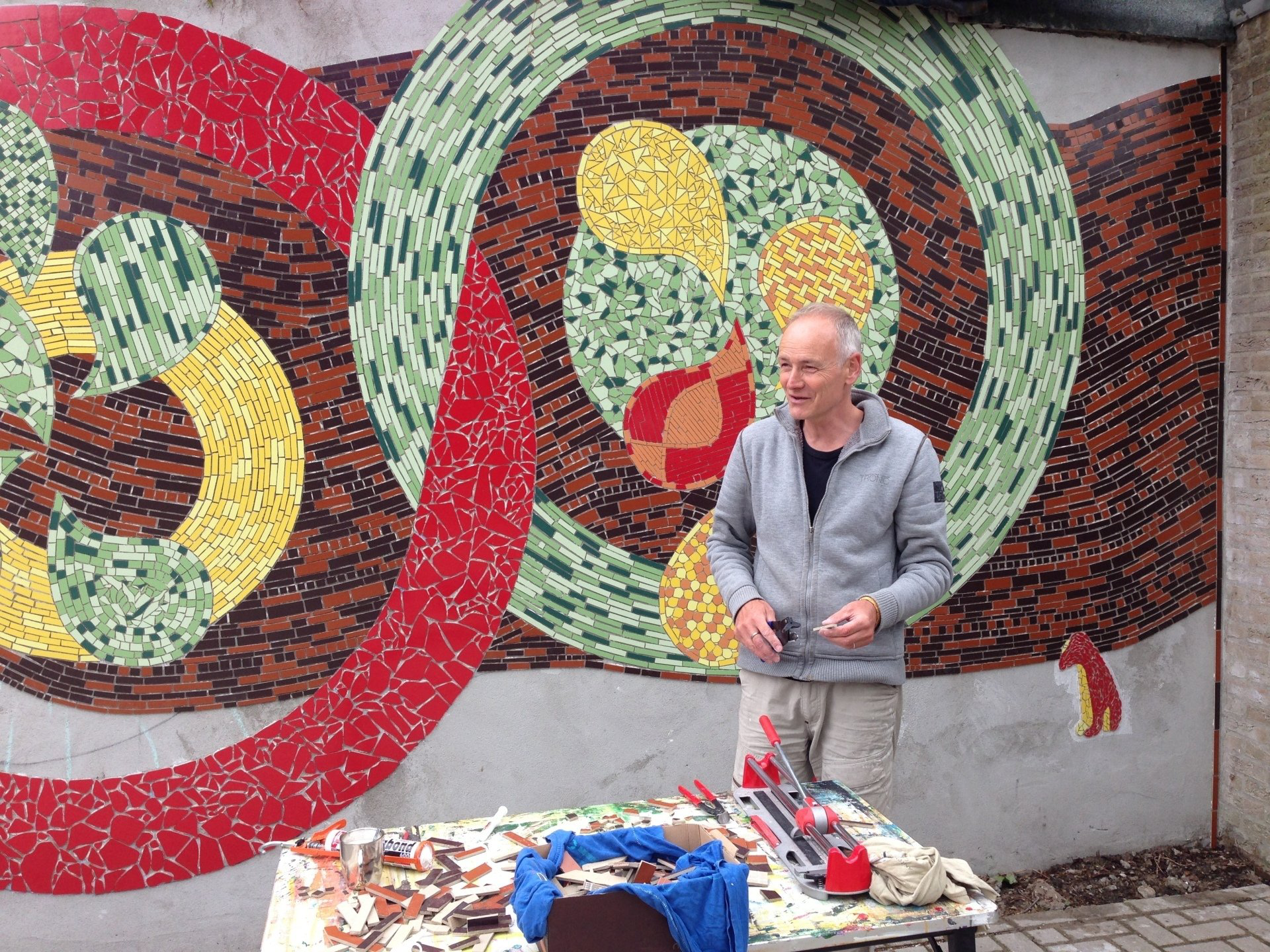’Watch from your gut, listen to your soul’ is the artistic vision of Peter Vial (1957). His starting point as a self-taught artist was a need to express his experience with social issues as well as personal development. In 2007 he started painting, but in 2010 he found the two-dimensional quality of painting too limiting and decided to explore the boundaries of mixed media techniques. He is now experimenting with new combinations of materials and techniques in three-dimensional works. It is in this period that he produced his first mosaic sculptures.
Vial produces three-dimensional and colourful works. He is inspired by De Stijl and uses geometrical constructions as a source of inspiration. A mosaic isn’t an end in itself, but a means to achieve a new kind of three-dimensionality. The artist is always looking for new constructions and forms. He first makes a rough design in aerated concrete. This material can be processed easily and the added outer layer is made of materials that are weatherproof, for his objects are intended to be part of the outdoors. He sees his work as scale models for architectural sculptures that may be expanded into life-size shapes. Vial assembles, disassembles and constructs as part of a creative process which he relates to self-reflection. The layers with which he covers his sculptures consist of mirrors, ceramics or glass. He also uses fragments of his own paintings, which he cuts up and recycles by attaching them to the underside of the cabochon cut glass. These are the building stones to help create extra depth in his mosaic art.
Wrapping up the shape is an intentional process. For Vial it is inextricably linked to letting go of memories and emotions. In the construction of his works he is always trying to create new designs by using shards and fragments. His personal process is keeping pace with this. He encountered the complex problems of families as a family manager in youth welfare. He now tries to deal with his experiences in this field in his works of art. By sticking mosaic tiles onto his sculptures he allows his thoughts free rein, thus offering new insights.
Vial is attracted to the idea of the romantic artist. He sees his work as a calling and his art as a direct reflection of his soul. Just like in 19th century Romanticism intuition, emotion and introspection are key, and spirituality plays major role. During the construction of his works he remains open to whatever may come into his head. He believes in self-development of the mind and attention to the subjective during the creative process, and he adds the romantic notion of artistic social commitment. For the aim of his art is to involve the beholder and the population into this process.
He creates works for specific locations in the Bijlmer district in the South-east of Amsterdam and thus delves into his relationship to his surroundings and the people living in it. In his most recent works he enters the domain of community art.
A good example of this is his mosaic ‘De Muur’ (‘The Wall’; 2013) at Huntum, a street in Amsterdam South-east. He developed this work following complaints by neighbours about the sad state of repair of a prominent wall in their neighbourhood. He designed a mosaic depicting the history of the wall for the owners and residents of the building. Families and neighbours are being symbolized by drops of water, a metaphor for life. Circles interlock, just like the lives of the various families. A bird points to the prosperity for the families and the neighbourhood. For Vial the success of the project was not only determined by producing a gem for the neighbourhood. More importantly it provided a connection, for neighbours came to see and discuss the work as he was creating it.
His latest work in a public space is ‘Voetpad’ (‘Footpath’; 2015), a guerrilla mosaic, which seems to be the latest trend, building on ideas like yarn bombing and guerrilla gardening. Street art plays an important role in the experience of the increasingly frugal public space, and Vial sees a role for himself in this. He wants to draw attention to overdue maintenance in the Bijlmer district in a playful way. For his future projects he is looking for bleak concrete walls, bent traffic signs and spontaneous rubbish tips. In his work Vial wants to encourage the neighbourhood’s commitment, put a smile on everyone’s face and increase public safety in the area. He sees his art as a means of communication. With his work he wants to connect the various cultures and nationalities in the Bijlmer district and invite them to reflect on this theme.
Hester Jenkins, art historian.


